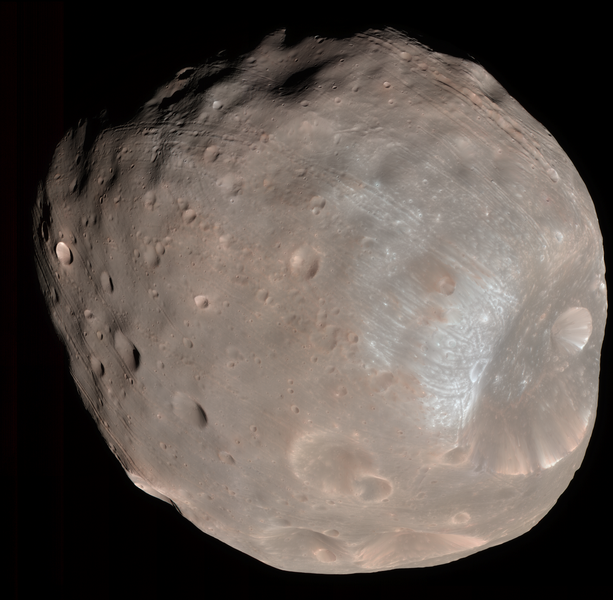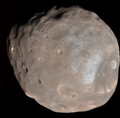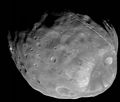Archivo:221831main PIA10368.png
Apariencia

Tamaño de esta previsualización: 613 × 600 píxeles. Otras resoluciones: 245 × 240 píxeles · 491 × 480 píxeles · 785 × 768 píxeles · 1047 × 1024 píxeles · 2094 × 2048 píxeles · 3374 × 3300 píxeles.
Ver la imagen en su resolución original (3374 × 3300 píxeles; tamaño de archivo: 15,26 MB; tipo MIME: image/png)
Historial del archivo
Haz clic sobre una fecha y hora para ver el archivo tal como apareció en ese momento.
| Fecha y hora | Miniatura | Dimensiones | Usuario | Comentario | |
|---|---|---|---|---|---|
| actual | 11:33 10 abr 2008 |  | 3374 × 3300 (15,26 MB) | Ævar Arnfjörð Bjarmason | {{Information |Description= Phobos from 6,800 Kilometers (Color) |Source= http://www.nasa.gov/mission_pages/MRO/multimedia/pia10368.html |Date= |Author= |Permission= |other_versions= http://www.nasa.gov/images/content/221831main_PIA10368.tif }} Downloade |
Usos del archivo
No hay páginas que enlacen a este archivo.
Uso global del archivo
Las wikis siguientes utilizan este archivo:
- Uso en ab.wikipedia.org
- Uso en az.wikipedia.org
- Uso en ba.wikipedia.org
- Uso en be.wikipedia.org
- Uso en ca.wikipedia.org
- Uso en ce.wikipedia.org
- Uso en cs.wikipedia.org
- Uso en da.wikipedia.org
- Uso en en.wikipedia.org
- Uso en eu.wikipedia.org
- Uso en fr.wikipedia.org
- Uso en fur.wikipedia.org
- Uso en ga.wikipedia.org
- Uso en gl.wikipedia.org
- Uso en gn.wikipedia.org
- Uso en gv.wikipedia.org
- Uso en he.wikipedia.org
- פובוס (ירח)
- פורטל:מתמטיקה/הידעת?/קטעי הידעת
- פורטל:מדעי החלל/הידעת?/קטעי הידעת?
- תבנית:הידעת? 6 בספטמבר - סדרה 1
- פורטל:מדעי החלל/הידעת?/13
- פורטל:גרמניה/הידעת?/קטעי הידעת?
- פורטל:גרמניה/הידעת?/42
- תבנית:הידעת? 6 בספטמבר 2012
- ויקיפדיה:הידעת?/2012/ספטמבר
- ויקיפדיה:הידעת?/2015/ספטמבר
- תבנית:הידעת? 6 בספטמבר 2015
- ויקיפדיה:הידעת?/2017/ספטמבר
- תבנית:הידעת? 7 בספטמבר 2017
- ויקיפדיה:הידעת?/2020/ספטמבר
- תבנית:הידעת? 3 בספטמבר 2020
- פורטל:פיזיקה/הידעת?/קטעי הידעת
- ויקיפדיה:הידעת?/2022/ספטמבר
- תבנית:הידעת? 3 בספטמבר 2022
- פורטל:פיזיקה/הידעת?/48
- פורטל:מתמטיקה/הידעת?/68
- Uso en hy.wikipedia.org
- Uso en ia.wikipedia.org
- Uso en it.wikipedia.org
Ver más uso global de este archivo.



